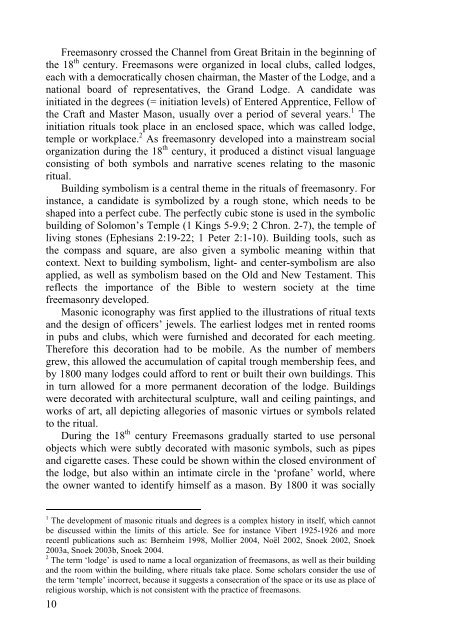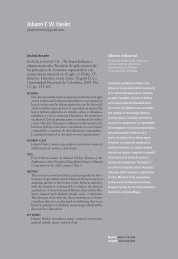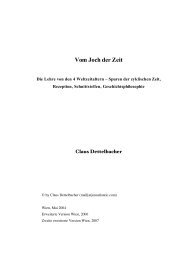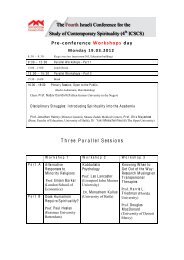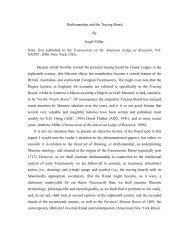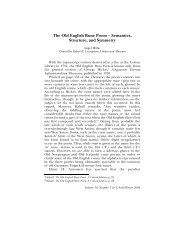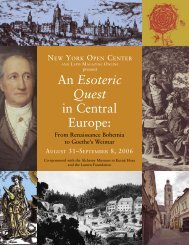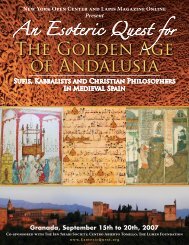Material for the introduction - Stichting OVN
Material for the introduction - Stichting OVN
Material for the introduction - Stichting OVN
Create successful ePaper yourself
Turn your PDF publications into a flip-book with our unique Google optimized e-Paper software.
Freemasonry crossed <strong>the</strong> Channel from Great Britain in <strong>the</strong> beginning of<br />
<strong>the</strong> 18 th century. Freemasons were organized in local clubs, called lodges,<br />
each with a democratically chosen chairman, <strong>the</strong> Master of <strong>the</strong> Lodge, and a<br />
national board of representatives, <strong>the</strong> Grand Lodge. A candidate was<br />
initiated in <strong>the</strong> degrees (= initiation levels) of Entered Apprentice, Fellow of<br />
<strong>the</strong> Craft and Master Mason, usually over a period of several years. 1 The<br />
initiation rituals took place in an enclosed space, which was called lodge,<br />
temple or workplace. 2 As freemasonry developed into a mainstream social<br />
organization during <strong>the</strong> 18 th century, it produced a distinct visual language<br />
consisting of both symbols and narrative scenes relating to <strong>the</strong> masonic<br />
ritual.<br />
Building symbolism is a central <strong>the</strong>me in <strong>the</strong> rituals of freemasonry. For<br />
instance, a candidate is symbolized by a rough stone, which needs to be<br />
shaped into a perfect cube. The perfectly cubic stone is used in <strong>the</strong> symbolic<br />
building of Solomon’s Temple (1 Kings 5-9.9; 2 Chron. 2-7), <strong>the</strong> temple of<br />
living stones (Ephesians 2:19-22; 1 Peter 2:1-10). Building tools, such as<br />
<strong>the</strong> compass and square, are also given a symbolic meaning within that<br />
context. Next to building symbolism, light- and center-symbolism are also<br />
applied, as well as symbolism based on <strong>the</strong> Old and New Testament. This<br />
reflects <strong>the</strong> importance of <strong>the</strong> Bible to western society at <strong>the</strong> time<br />
freemasonry developed.<br />
Masonic iconography was first applied to <strong>the</strong> illustrations of ritual texts<br />
and <strong>the</strong> design of officers’ jewels. The earliest lodges met in rented rooms<br />
in pubs and clubs, which were furnished and decorated <strong>for</strong> each meeting.<br />
There<strong>for</strong>e this decoration had to be mobile. As <strong>the</strong> number of members<br />
grew, this allowed <strong>the</strong> accumulation of capital trough membership fees, and<br />
by 1800 many lodges could af<strong>for</strong>d to rent or built <strong>the</strong>ir own buildings. This<br />
in turn allowed <strong>for</strong> a more permanent decoration of <strong>the</strong> lodge. Buildings<br />
were decorated with architectural sculpture, wall and ceiling paintings, and<br />
works of art, all depicting allegories of masonic virtues or symbols related<br />
to <strong>the</strong> ritual.<br />
During <strong>the</strong> 18 th century Freemasons gradually started to use personal<br />
objects which were subtly decorated with masonic symbols, such as pipes<br />
and cigarette cases. These could be shown within <strong>the</strong> closed environment of<br />
<strong>the</strong> lodge, but also within an intimate circle in <strong>the</strong> ‘profane’ world, where<br />
<strong>the</strong> owner wanted to identify himself as a mason. By 1800 it was socially<br />
1 The development of masonic rituals and degrees is a complex history in itself, which cannot<br />
be discussed within <strong>the</strong> limits of this article. See <strong>for</strong> instance Vibert 1925-1926 and more<br />
recentl publications such as: Bernheim 1998, Mollier 2004, Noël 2002, Snoek 2002, Snoek<br />
2003a, Snoek 2003b, Snoek 2004.<br />
2 The term ‘lodge’ is used to name a local organization of freemasons, as well as <strong>the</strong>ir building<br />
and <strong>the</strong> room within <strong>the</strong> building, where rituals take place. Some scholars consider <strong>the</strong> use of<br />
<strong>the</strong> term ‘temple’ incorrect, because it suggests a consecration of <strong>the</strong> space or its use as place of<br />
religious worship, which is not consistent with <strong>the</strong> practice of freemasons.<br />
10


